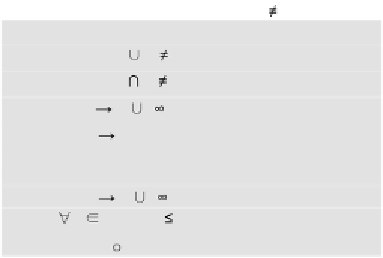Biology Reference
In-Depth Information
Box 1: PN-Definition
Box 2: PN firing rules for P/T-nets
A
Petri net
is a directed, labeled, bipartite graph
consisting of places (circles), transitions (rectangles)
and weighted arcs (arrows). It is defined as a six-tuple
Y
= (
P
,
T
,
F
,
K
,
W
,
M
0
) [
Baumgarten, 1996
Activity of reactions in a P/T-net (defined in
Box 1
) is simulated by
firing of transitions, which is symbolized by a token change. A
transition
t
can only fire, i.e. if it is enabled by satisfying following
two conditions:
1.
M
(
t
)
W
(
p
i
,
t
) : all its pre-places are occupied
by at least as many tokens as the weights of the
incoming arcs prescribe.
2.
K
(
t
)
W
(
t
,
p
i
) : all its post-places must have at
least a capacity as the the weights of the outgoing arcs
dictate
]:
i.The tuple (
P
,
T
,
F
) is a net graph
N
with
a.
P
= {
p
1
,
p
2
, ...,
p
n
}; set of
places
b.
T
= {
t
1
,
t
2
, ...,
t
n
}; set of
transitions
c.
F
(
P
T
) (T P) set
of
arcs
(flux relations of
N
)
d.
P
/
T
/
e.
P T
ii.
K
:
P
{ };
capacity
of places
iii.
W
:
F
; arc weights
iv.Dynamics of PN is realized by movable
objects, the tokens, which define a
M
:
P
/
Transition firing behavior:
a) Transition
t
1 is enabled because
pre-places
p
1 and
p
2 are occupied by as many tokens as their arc
weights prescribe. Missing arc weight means per default an arc
weight of one, b) After firing of
t
1 two tokens of
p
1 and one token of
p
2 are consumed and three tokens of
p
3 are produced. Note that
the number of consumed tokens must not necessarily be equal to
the number of produced tokens.
};
marking
of
Y
if
{
p
P
:
M
(
p
)
K
(
p
) with:
M
0
:
P
0
:
initial
marking
M
0
M'
: the
consecutive marking
given a
firing sequence
w
M
0
defines a firing
sequence, which is activated
under
M
0
for which holds:
w
=
/
M'
=
M
0
or
M'
M
(
Y
) :
M
0
M'
are called output transitions and represent sinks. These transitions model the interface to the system's
environment.
The dynamic behavior of the network is realized through the firing of transitions, which model the
activity of biochemical reactions. A transition can fire (is enabled) if all pre-places are covered by at least
as many tokens as indicated by the corresponding arc weights. During
firing
of a transition according
to the corresponding arc weights and firing rules (Box 2), the number of tokens is decreased on the
preplaces and increased on the post-places at the same time (Box 2). Consequently, the
marking
of the
net is changing, resulting in a new state of the PN. Note that in signal transduction networks without mass
flow and reaction stoichiometry, it is reasonable to interpret arc weights rather as “information units”
with a default value of one than as reaction quantities. Starting from an initial marking
M
0
, we define
a
firing sequence
M
0
w
→
T
as a subset of transitions of the PN, which corresponds to
a specific signal propagation through the biological network. For each firing sequence
w
, a frequency
vector
w
=
(#(
t
1
,
w
)
...
#(
t
n
,
w
)) (also called
Parikh-vector
) can be assigned, which indicates how often
each transition fires. The change of the net marking can be determined by:
,w
=
t
1
...t
k
∈
w
→
M
=
M
0
+
C
M
0
·
w
(1)
whereat
C
is the incidence matrix of the PN, in which rows and columns correspond to
P
and
T
,














